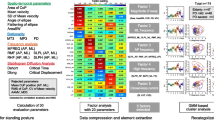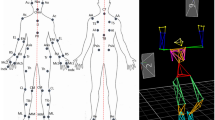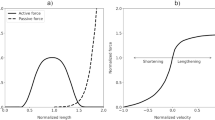Abstract
Previous studies of postural preparation to action/perturbation have primarily focused on anticipatory postural adjustments (APAs), the changes in muscle activation levels resulting in the production of net forces and moments of force. We hypothesized that postural preparation to action consists of two stages: (1) Early postural adjustments (EPAs), seen a few hundred ms prior to an expected external perturbation and (2) APAs seen about 100 ms prior to the perturbation. We also hypothesized that each stage consists of three components, anticipatory synergy adjustments seen as changes in covariation of the magnitudes of commands to muscle groups (M-modes), changes in averaged across trials levels of muscle activation, and mechanical effects such as shifts of the center of pressure. Nine healthy participants were subjected to external perturbations created by a swinging pendulum while standing in a semi-squatting posture. Electrical activity of twelve trunk and leg muscles and displacements of the center of pressure were recorded and analyzed. Principal component analysis was used to identify four M-modes within the space of muscle activations using indices of integrated muscle activation. This analysis was performed twice, over two phases, 400–700 ms prior to the perturbation and over 200 ms just prior to the perturbation. Similar robust results were obtained using the data from both phases. An index of a multi-M-mode synergy stabilizing the center of pressure displacement was computed using the framework of the uncontrolled manifold hypothesis. The results showed high synergy indices during quiet stance. Each of the two stages started with a drop in the synergy index followed by a change in the averaged across trials activation levels in postural muscles. There was a very long electromechanical delay during the early postural adjustments and a much shorter delay during the APAs. Overall, the results support our main hypothesis on the two stages and three components of the postural preparation to action/perturbation. This is the first study to document anticipatory synergy adjustments in whole-body tasks. We interpret the results within the referent configuration hypothesis (an extension of the equilibrium-point hypothesis): The early postural adjustment is based primarily on changes in the coactivation command, while the APAs involve changes in the reciprocal command. The results fit an earlier hypothesis that whole-body movements are controlled by a neuromotor hierarchy where each level involves a few-to-many mappings organized to stabilize its overall output.








Similar content being viewed by others
References
Alexandrov AV, Frolov AA, Massion J (2001) Biomechanical analysis of movement strategies in human forward trunk bending. II. Experimental study. Biol Cybern 84:435–443
Aruin AS, Latash ML (1995) The role of motor action in anticipatory postural adjustments studied with self-induced and externally triggered perturbations. Exp Brain Res 106:291–300
Aruin AS, Latash ML (1996) Anticipatory postural adjustments during self-initiated perturbations of different magnitude triggered by a standard motor action. Electroencephalogr Clin Neurophysiol 101:497–503
Asaka T, Wang Y, Fukushima J, Latash ML (2008) Learning effects on muscle modes and multi-mode postural synergies. Exp Brain Res 184:323–338
Basmajian JV (1980) Electromyography—dynamic gross anatomy: a review. Am J Anat 159:245–260
Belenkiy V, Gurfinkel V, Pal’tsev Y (1967) Elements of control of voluntary movements. Biofizika 10:135–141
Bernstein N (1967) The coordination and regulation of movements. Pergamon Press, London
Bouisset S, Zattara M (1987) Biomechanical study of the programming of anticipatory postural adjustments associated with voluntary movement. J Biomech 20:735–742
Cavanagh PR, Komi PV (1979) Electromechanical delay in human skeletal muscle under concentric and eccentric contractions. Eur J Appl Physiol Occup Physiol 42:159–163
Corcos DM, Gottlieb GL, Latash ML, Almeida GL, Agarwal GC (1992) Electromechanical delay: an experimental artifact. J Electromyogr Kinesiol 2:59–68
Cordo PJ, Nashner LM (1982) Properties of postural adjustments associated with rapid arm movements. J Neurophysiol 47:287–302
Couillandre A, Maton B, Breniere Y (2002) Voluntary toe-walking gait initiation: electromyographical and biomechanical aspects. Exp Brain Res 147:313–321
Crenna P, Frigo C (1991) A motor programme for the initiation of forward-oriented movements in humans. J Physiol 437:635–653
d’Avella A, Saltiel P, Bizzi E (2003) Combinations of muscle synergies in the construction of a natural motor behavior. Nat Neurosci 6:300–308
Danna-Dos-Santos A, Slomka K, Zatsiorsky VM, Latash ML (2007) Muscle modes and synergies during voluntary body sway. Exp Brain Res 179:533–550
Danna-Dos-Santos A, Degani AM, Latash ML (2008) Flexible muscle modes and synergies in challenging whole-body tasks. Exp Brain Res 189:171–187
De Wolf S, Slijper H, Latash ML (1998) Anticipatory postural adjustments during self-paced and reaction-time movements. Exp Brain Res 121:7–19
Elble RJ, Moody C, Leffler K, Sinha R (1994) The initiation of normal walking. Mov Disord 9:139–146
Feldman AG (1966) On the functional tuning of the nervous system in movement control or preservation of stationary pose. II. Adjustable parameters in muscles. Biofizika 11:498–508
Feldman AG (1980) Superposition of motor programs–I. Rhythmic forearm movements in man. Neuroscience 5:81–90
Feldman AG (1986) Once more on the equilibrium-point hypothesis (lambda model) for motor control. J Mot Behav 18:17–54
Feldman AG, Latash ML (1982) Afferent and efferent components of joint position sense; interpretation of kinaesthetic illusion. Biol Cybern 42:205–214
Feldman AG, Levin MF (1995) The origin and use of positional frames of reference in motor control. Behav Br Sci 18:723–744
Feldman AG, Orlovsky GN (1972) The influence of different descending systems on the tonic stretch reflex in the cat. Exp Neurol 37:481–494
Feldman AG, Goussev V, Sangole A, Levin MF (2007) Threshold position control and the principle of minimal interaction in motor actions. Prog Brain Res 165:267–281
Hair JF, Anderson RE, Tatham RL, Black WC (1995) Factor analysis. In: Borkowski D (ed) Multivariate data analysis. Prentice Hall, Englewood Cliffs, pp 364–404
Halliday SE, Winter DA, Frank JS, Patla AE, Prince F (1998) The initiation of gait in young, elderly, and Parkinson’s disease subjects. Gait Posture 8:8–14
Hermens HJ, Freriks B, Disselhorst-Klug C, Rau G (2000) Development of recommendations for SEMG sensors and sensor placement procedures. J Electromyogr Kinesiol 10:361–374
Hirschfeld H, Forssberg H (1991) Phase-dependent modulations of anticipatory postural activity during human locomotion. J Neurophysiol 66:12–19
Howatson G, Glaister M, Brouner J, van Someren KA (2009) The reliability of electromechanical delay and torque during isometric and concentric isokinetic contractions. J Electromyogr Kinesiol 19:975–979
Ivanenko YP, Cappellini G, Dominici N, Poppele RE, Lacquaniti F (2005) Coordination of locomotion with voluntary movements in humans. J Neurosci 25:7238–7253
Ivanenko YP, Wright WG, Gurfinkel VS, Horak F, Cordo P (2006) Interaction of involuntary post-contraction activity with locomotor movements. Exp Brain Res 169:255–260
Jacobs JV, Nutt JG, Carlson-Kuhta P, Stephens M, Horak FB (2009) Knee trembling during freezing of gait represents multiple anticipatory postural adjustments. Exp Neurol 215:334–341
Kim SW, Shim JK, Zatsiorsky VM, Latash ML (2006) Anticipatory adjustments of multi-finger synergies in preparation for self-triggered perturbations. Exp Brain Res 174:604–612
Klous M, Danna-dos-Santos A, Latash ML (2010) Multi-muscle synergies in a dual postural task: evidence for the principle of superposition. Exp Brain Res 202:457–471
Klous M, Mikulic P, Latash ML (2011) Two Aspects of feed-forward postural control: anticipatory postural adjustments and anticipatory synergy adjustments. J Neurophysiol. doi:10.1152/JN.00665.2010
Krishnamoorthy V, Latash ML (2005) Reversals of anticipatory postural adjustments during voluntary sway in humans. J Physiol 565:675–684
Krishnamoorthy V, Goodman S, Zatsiorsky V, Latash ML (2003a) Muscle synergies during shifts of the center of pressure by standing persons: identification of muscle modes. Biol Cybern 89:152–161
Krishnamoorthy V, Latash ML, Scholz JP, Zatsiorsky VM (2003b) Muscle synergies during shifts of the center of pressure by standing persons. Exp Brain Res 152:281–292
Krishnamoorthy V, Latash ML, Scholz JP, Zatsiorsky VM (2004) Muscle modes during shifts of the center of pressure by standing persons: effect of instability and additional support. Exp Brain Res 157:18–31
Kung UM, Horlings CG, Honegger F, Allum JH (2009) Incorporating voluntary unilateral knee flexion into balance corrections elicited by multi-directional perturbations to stance. Neuroscience 163:466–481
Latash ML (2010a) Motor synergies and the equilibrium-point hypothesis. Mot Control 14:294–322
Latash ML (2010b) Stages in learning motor synergies: a view based on the equilibrium-point hypothesis. Hum Mov Sci 29:642–654
Latash ML, Zatsiorsky VM (2009) Multi-finger prehension: control of a redundant mechanical system. Adv Exp Med Biol 629:597–618
Latash ML, Gelfand IM, Li ZM, Zatsiorsky VM (1998) Changes in the force-sharing pattern induced by modifications of visual feedback during force production by a set of fingers. Exp Brain Res 123:255–262
Latash ML, Scholz JP, Schoner G (2002) Motor control strategies revealed in the structure of motor variability. Exerc Sport Sci Rev 30:26–31
Latash ML, Scholz JP, Schoner G (2007) Toward a new theory of motor synergies. Mot Control 11:276–308
Latash ML, Friedman J, Kim SW, Feldman AG, Zatsiorsky VM (2010a) Prehension synergies and control with referent hand configurations. Exp Brain Res 202:213–229
Latash ML, Levin MF, Scholz JP, Schoner G (2010b) Motor control theories and their applications. Medicina (Kaunas) 46:382–392
Lepers R, Breniere Y (1995) The role of anticipatory postural adjustments and gravity in gait initiation. Exp Brain Res 107:118–124
Li X, Aruin AS (2007) The effect of short-term changes in the body mass on anticipatory postural adjustments. Exp Brain Res 181:333–346
Li ZM, Latash ML, Zatsiorsky VM (1998) Force sharing among fingers as a model of the redundancy problem. Exp Brain Res 119:276–286
Massion J (1992) Movement, posture and equilibrium: interaction and coordination. Prog Neurobiol 38:35–56
Nana-Ibrahim S, Vieilledent S, Leroyer P, Viale F, Zattara M (2008) Target size modifies anticipatory postural adjustments and subsequent elementary arm pointing. Exp Brain Res 184:255–260
Olafsdottir H, Yoshida N, Zatsiorsky VM, Latash ML (2005) Anticipatory covariation of finger forces during self-paced and reaction time force production. Neurosci Lett 381:92–96
Pilon JF, De Serres SJ, Feldman AG (2007) Threshold position control of arm movement with anticipatory increase in grip force. Exp Brain Res 181:49–67
Ramos CF, Stark LW (1990) Postural maintenance during fast forward bending: a model simulation experiment determines the reduced trajectory. Exp Brain Res 82:651–657
Robert T, Zatsiorsky VM, Latash ML (2008) Multi-muscle synergies in an unusual postural task: quick shear force production. Exp Brain Res 187:237–253
Saltiel P, Wyler-Duda K, D’Avella A, Tresch MC, Bizzi E (2001) Muscle synergies encoded within the spinal cord: evidence from focal intraspinal NMDA iontophoresis in the frog. J Neurophysiol 85:605–619
Santos MJ, Aruin AS (2008) Role of lateral muscles and body orientation in feed forward postural control. Exp Brain Res 184:547–559
Santos MJ, Kanekar N, Aruin AS (2010) The role of anticipatory postural adjustments in compensatory control of posture: 1. Electromyographic analysis. J Electromyogr Kinesiol 20:388–397
Scholz JP, Schoner G (1999) The uncontrolled manifold concept: identifying control variables for a functional task. Exp Brain Res 126:289–306
Shadmehr R, Wise SP (2005) The computational neurobiology of reaching and pointing. MIT Press, Cambridge
Shim JK, Olafsdottir H, Zatsiorsky VM, Latash ML (2005) The emergence and disappearance of multi-digit synergies during force-production tasks. Exp Brain Res 164:260–270
Shim JK, Park J, Zatsiorsky VM, Latash ML (2006) Adjustments of prehension synergies in response to self-triggered and experimenter-triggered load and torque perturbations. Exp Brain Res 175:641–653
Slijper H, Latash M (2000) The effects of instability and additional hand support on anticipatory postural adjustments in leg, trunk, and arm muscles during standing. Exp Brain Res 135:81–93
Stapley P, Pozzo T, Grishin A (1998) The role of anticipatory postural adjustments during whole body forward reaching movements. Neuroreport 9:395–401
Ting LH (2007) Dimensional reduction in sensorimotor systems: a framework for understanding muscle coordination of posture. Prog Brain Res 165:299–321
Ting LH, Chvatal SA (2010) Decomposing muscle activity in motor tasks. In: Danion F, Latash ML (eds) Motor control. Theories, experiments and applications. Oxford University Press, NY, pp 102–138
Ting LH, Macpherson JM (2005) A limited set of muscle synergies for force control during a postural task. J Neurophysiol 93:609–613
Torres-Oviedo G, Ting LH (2007) Muscle synergies characterizing human postural responses. J Neurophysiol 98:2144–2156
Torres-Oviedo G, Macpherson JM, Ting LH (2006) Muscle synergy organization is robust across a variety of postural perturbations. J Neurophysiol 96:1530–1546
Tresch MC, Jarc A (2009) The case for and against muscle synergies. Curr Opin Neurobiol 19:601–607
Valero-Cuevas FJ, Venkadesan M, Todorov E (2009) Structured variability of muscle activations supports the minimal intervention principle of motor control. J Neurophysiol 102:59–68
Winter DA, Prince F, Frank JS, Powell C, Zabjek KF (1996) Unified theory regarding A/P and M/L balance in quiet stance. J Neurophysiol 75:2334–2343
Acknowledgments
This study was supported in part by NIH grant NS-035032 and NIDRR grant H133P060003. We thank Maria Reyes Lopez Cerezo for her assistance in the data collection, and Neeta Kanekar and Sambit Mohapatra for their helpful suggestions regarding the data collection. We are also grateful to Miriam Klous for her valuable input related to data processing.
Author information
Authors and Affiliations
Corresponding author
Rights and permissions
About this article
Cite this article
Krishnan, V., Aruin, A.S. & Latash, M.L. Two stages and three components of the postural preparation to action. Exp Brain Res 212, 47–63 (2011). https://doi.org/10.1007/s00221-011-2694-z
Received:
Accepted:
Published:
Issue Date:
DOI: https://doi.org/10.1007/s00221-011-2694-z




